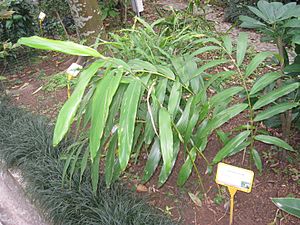Wurfbainia villosa facts for kids
Quick facts for kids Wurfbainia villosa |
|
|---|---|
 |
|
| Wurfbainia villosa at the Hong Kong Botanical Garden | |
| Conservation status | |
| Scientific classification | |
| Genus: |
Wurfbainia
|
| Species: |
villosa
|
| Synonyms | |
|
|
Wurfbainia villosa, also known as Amomum villosum, is a plant in the ginger family. It grows in many parts of Southeast Asia and South China. This plant is grown for its fruits, which are like small pods. Inside these pods are seeds that smell very nice and are used as a spice, similar to cardamom.
Wurfbainia villosa is an evergreen plant, meaning it stays green all year. It grows in the shade of trees and can reach a height of 1.5 to 3.0 meters (about 5 to 10 feet). Its branches and leaves look a lot like those of the ginger plant. A cool fact about this plant is that only its flowers that grow on the ground can turn into fruit. Flowers that grow on the branches do not. Its beautiful white flowers bloom in March and April.
How We Use This Plant
The seeds from Wurfbainia villosa are a popular spice. They are used in Chinese cooking to add flavor. You might find them in some types of five-spice powder, which is a mix of different spices.
People have used this spice for a very long time. Ancient books from the Tang Dynasty (a long time ago in China), like the Compendium of Materia Medica, describe its taste. They say Wurfbainia villosa tastes spicy, fresh, and a little bit bitter.
Protecting Wurfbainia villosa
People really want the seeds and ripe fruits of Wurfbainia villosa. Because of this high demand, some people used to clear parts of forests by cutting and burning trees. This practice is called slash-and-burn.
To help stop this, governments in places like Yunnan and Guangdong, China, have encouraged farmers to grow Wurfbainia villosa in special ways. They even suggest planting it alongside rubber trees. This helps meet the demand without harming the natural forests as much.
However, growing too much Wurfbainia villosa in forests can also cause problems. When too much of one plant is grown, it can reduce the number of different plant types in the rainforests of Southwest China. Keeping many different kinds of plants is important for a healthy forest.


